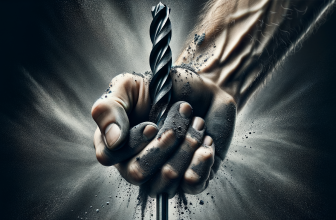
Our Top Picks
Have you ever found yourself in the middle of a DIY project and realized that the one thing slowing you down is not having the right oscillating tool blade for the job? It’s an understandable dilemma given the vast array of options out there. To help you cut through the confusion, we’ve gone in-depth, tested products, and scoured over thousands of reviews to bring you the very best oscillating tool blades. But before we reveal our top picks, let’s explore what you need to know before making your purchase.
Our #1 Top Pick: Imperial Blades IBOA800-1 One Fit 4-IN-1 Features Blade
The Imperial Blades IBOA800-1 stands out as a multitasking powerhouse, offering a 4-in-1 design that’s ideal for a range of applications. Built to cut wood, drywall, and metal, this blade’s versatility is unmatched. The One Fit design ensures compatibility with most oscillating tool brands, and its titanium-enhanced bi-metal construction offers exceptional durability. Users praise its ability to maintain sharpness even after multiple demanding projects.
Pick #2: DEWALT DWA4216 5-Piece Oscillating Accessory Kit
DEWALT is synonymous with quality, and their DWA4216 5-Piece Kit doesn’t disappoint. This set gives you a variety of blades including wood, wood with nails, and fast-cut wood blades, making it a comprehensive addition to any toolkit. The UNIVERSAL FITMENT™ allows for use with most oscillating tools, providing added convenience. Reviewers love the Tough Case it comes with, which is durable and helps keep the blades organized.
Pick #3: Bosch OSL005C Five-Piece Starlock Oscillating Multi Tool Blade Set
The Bosch OSL005C set is specifically designed for users looking for precision and efficiency. The Starlock interface provides a sturdy blade-to-tool connection, improving control and delivering better torque transfer. The set includes blades for plunge cutting, segment sawing, and scraping, covering most renovation and remodeling needs. The high-carbon steel material is another plus, offering impressive longevity as noted by several users.
Pick #4: ROCKWELL RW8981K Universal Fit End Cut Blade Kit
Rockwell’s RW8981K Blade Kit comes with multiple blades that fit all oscillating tools without adapters, proving ease-of-use and convenience. This kit is admirable for its universal fit end cut blades, which are perfect for cutting wood, plastic, and drywall. Users often mention the value for money, especially since it includes precision, standard, and bi-metal blades. As an added benefit, the kit offers color-coded rings for easy blade identification.
Pick #5: XXGO XG8502D 20 Pcs Universal Oscillating Multi Tool Saw Blades Set
For the budget-conscious, the XXGO XG8502D provides a plethora of options with its 20-piece set. It includes semi-circular, bi-metal, and precision Japan tooth blades, giving you an impressive range for tackling different materials and tasks. While they may not have the same brand recognition as others, users are pleasantly surprised by their performance and durability, providing an excellent cost-to-quality ratio.
What to Know Before You Buy
- Compatibility: Verify that the blades you’re interested in are compatible with your oscillating tool model.
- Materials: Determine the types of materials you’ll be working on, as some blades are designed for specific uses like wood, metal, or bi-material applications.
- Intended Use: Consider the tasks at hand – are you scraping, cutting, sanding, or grout removing? The job will dictate the blade type you need.
- Brand Reputation: Well-known brands often deliver on quality and warranty support, but don’t ignore up-and-coming brands that may offer value.
- Set or Single: Depending on the frequency of use and variety of projects, decide if a single blade or a set is more cost-effective for your needs.
Factors to Consider Before Buying
- Blade Material: High-quality materials like bi-metal or carbide-tipped blades can offer increased durability and a longer lifespan.
- Teeth Per Inch (TPI): Blades with a higher TPI cut slower but smoother, ideal for metal cutting, while a lower TPI allows for faster, though rougher, wood cutting.
- Design: Look at the shape and design of the blade. Some are better suited for precision work, while others are for bulk material removal.
- Price: A higher-priced blade might last longer and perform better, yet there are affordable options that also do an admirable job.
- User Reviews: User experiences can provide insights into performance and durability that specs and marketing might not reveal.
Why Trust ChooseRight?
At ChooseRight, we take pride in providing in-depth reviews that help you make informed decisions. For the selection of the best oscillating tool blades, we have put in the legwork, analyzing thousands of user reviews to understand real-world performance and endurance. We’ve consulted with seasoned professionals across various trades to hear firsthand which blades stand up to the demands of serious work. With this meticulous approach, we aim to ensure that our recommendations serve your needs reliably.
Finishing Thoughts
Selecting the best oscillating tool blade can mean the difference between a job well done and one that’s filled with frustration. By considering our top picks, together with the important buying knowledge and factors we’ve shared, you’re well-equipped to choose the right blade for your oscillating tool. Remember to reflect on the types of projects you undertake most often and pick a blade that aligns with your tool’s compatibility and intended uses. With the right blade in hand, your craft and projects will feel less like work and more like a demonstration of your skills.
Frequently Asked Questions
What are oscillating tool blades used for?
Oscillating tool blades are versatile attachments for an oscillating tool, which can be used for various projects, including cutting, sanding, scraping, and polishing a variety of materials such as wood, metal, plastic, drywall, and more.
Can oscillating tool blades be used on any brand of oscillating tools?
Most oscillating tool blades are designed to be compatible with a range of oscillating tools. However, it’s important to check the blade’s compatibility with your specific tool brand and model, as some tools may require an adapter or may have a proprietary blade fitting system.
How do I choose the right oscillating tool blade for my project?
To choose the right blade, consider the material you’ll be working with and the type of cut you need to make. For example, use a blade with fine teeth for clean cuts in wood, a carbide-tipped blade for harder materials, and a bi-metal or titanium-coated blade for metal. The blade’s packaging typically indicates its intended use.
How often should I replace my oscillating tool blades?
The lifespan of an oscillating tool blade depends on various factors, including the material you’re cutting, the quality of the blade, and the frequency of use. You’ll know it’s time to replace the blade when it becomes dull, doesn’t cut efficiently, or if the teeth are damaged.
Are there any safety precautions I should take when using oscillating tool blades?
Yes, always wear proper safety gear including safety glasses and gloves. Ensure the blade is securely attached to the oscillating tool and avoid applying excessive pressure during use to prevent blade breakage or slippage. Always follow the manufacturer’s instructions and guidelines for safe use.
Can oscillating tool blades be sharpened?
Some oscillating tool blades can be sharpened if they are made of a suitable material, such as high carbon steel. However, many blades are disposable and are not designed to be re-sharpened due to coating or the type of teeth. Consult the manufacturer’s recommendations before attempting to sharpen a blade.
Are there any multi-purpose blades available for oscillating tools?
Yes, there are multi-purpose blades designed for oscillating tools that can handle a variety of materials, offering a good balance for users who need to cut different materials without changing blades frequently.
What’s the difference between a wood-cutting oscillating blade and a metal-cutting blade?
Wood-cutting blades typically have larger teeth and are designed to cut through wood and other soft materials. Metal-cutting blades, on the other hand, have smaller, more frequent teeth made of harder materials like bi-metal or carbide to resist the hardness of metals.
How do I maintain my oscillating tool blades?
To maintain your blades, keep them clean by wiping away residue or buildup after each use. Store them properly to avoid damage, and if they are suitable for sharpening, maintain their edge for optimal performance. Always handle blades with care to prolong their lifespan.







